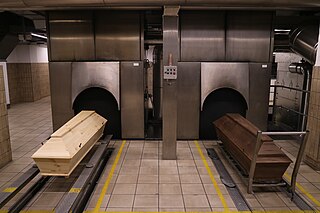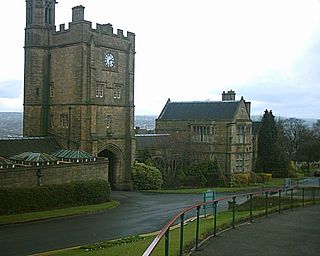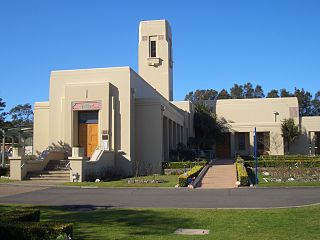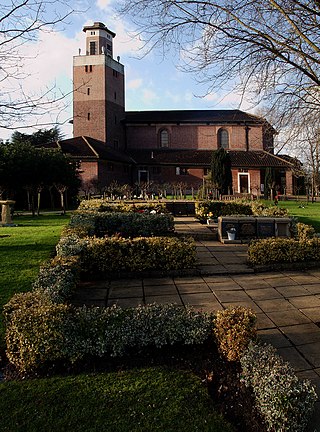
Cremation is a method of final disposition of a dead body through burning.

The London Necropolis Company (LNC), formally the London Necropolis & National Mausoleum Company until 1927, was a cemetery operator established by Act of Parliament in 1852 in reaction to the crisis caused by the closure of London's graveyards in 1851. The LNC intended to establish a single cemetery large enough to accommodate all of London's future burials in perpetuity. The company's founders recognised that the recently invented technology of the railway provided the ability to conduct burials far from populated areas, mitigating concerns over public health risks from living near burial sites. Accordingly, the company bought a very large tract of land in Brookwood, Surrey, around 25 miles (40 km) from London, and converted a portion of it into Brookwood Cemetery. A dedicated railway line, the London Necropolis Railway, linked the new cemetery to the city.

West Norwood Cemetery is a 40-acre (16 ha) rural cemetery in West Norwood in London, England. It was also known as the South Metropolitan Cemetery. One of the first private landscaped cemeteries in London, it is one of the "Magnificent Seven" cemeteries of London, and is a site of major historical, architectural and ecological interest.

Allerton Cemetery is a cemetery in Allerton, Liverpool, England. The cemetery, of 150 acres (61 ha), is one of the main burial sites for the Metropolitan Borough of Liverpool and is Grade II listed. Springwood Crematorium is situated opposite the cemetery on Springwood Avenue. Purchase of the land for the cemetery was completed in October 1906, the Church of England section was consecrated by the Bishop of Liverpool on 24 September 1909, and the first burial in the cemetery took place on 29 December 1909. It is still in operation.

The City Road Cemetery is a cemetery in the City of Sheffield, England that opened in May 1881 and was originally Intake Road Cemetery. Covering 100 acres (40 ha) it is the largest and is the head office for all the municipally owned cemeteries in Sheffield. The cemetery contains Sheffield Crematorium, whose first cremation was on 24 April 1905.

Cremation is a method used to dispose of the deceased in the Christian world despite historical opposition to the practice.

Deaths in Singapore offset the population increase from live births. In 2007, 17,140 people in Singapore died from various causes. The death rate was 4.5 deaths per 1,000 of the population. There are strict regulations surrounding death and treatment of the body after death.

Mitcham Road Cemetery, previously called Croydon Cemetery, is a cemetery located next to Mitcham Common near Croydon, which is part of the London Borough of Croydon, London. Croydon Crematorium is located inside the cemetery, and are both managed by Croydon Cemeteries and Crematoriums. The cemetery is much larger than other ones in London. There is also a chapel located inside the cemetery.

Eastern Suburbs Memorial Park, Eastern Suburbs Crematorium and Botany General Cemetery, is a cemetery and crematorium on Bunnerong Road in Matraville, New South Wales, in the eastern suburbs district of Sydney, Australia.

The Cremation Act 1902 is an Act of Parliament of the Parliament of the United Kingdom. The major purpose of the Act was to allow burial authorities to establish crematoria. Later revisions of the Act outlawed open air cremations using funeral pyres, although in 2010 the Court of Appeal ruled this practice to be legal under certain circumstances.

South London Crematorium and Streatham Park Cemetery is a cemetery and crematorium on Rowan Road in Streatham Vale. It has always been privately owned and managed and is now part of the Dignity plc group. The South London Crematorium is situated within the cemetery grounds and opened in 1936.

Southern Cemetery is a large municipal cemetery in Chorlton-cum-Hardy, Manchester, England, 3 miles (4.8 km) south of the city centre. It opened in 1879 and is owned and administered by Manchester City Council. It is the largest municipal cemetery in the United Kingdom and the second largest in Europe.

The City of London Cemetery and Crematorium is a cemetery and crematorium in the east of London. It is owned and operated by the City of London Corporation. It is designated Grade I on the Historic England National Register of Historic Parks and Gardens.

East Finchley Cemetery is a cemetery and crematorium in East End Road, East Finchley. Although it is in the London Borough of Barnet, it is owned and managed by the City of Westminster.

The English coastal city of Brighton and Hove, made up of the formerly separate Boroughs of Brighton and Hove in East Sussex, has a wide range of cemeteries throughout its urban area. Many were established in the mid-19th century, a time in which the Victorian "cult of death" encouraged extravagant, expensive memorials set in carefully cultivated landscapes which were even recommended as tourist attractions. Some of the largest, such as the Extra Mural Cemetery and the Brighton and Preston Cemetery, were set in particularly impressive natural landscapes. Brighton and Hove City Council, the local authority responsible for public services in the city, manages seven cemeteries, one of which also has the city's main crematorium. An eighth cemetery and a second crematorium are owned by a private company. Many cemeteries are full and no longer accept new burials. The council maintains administrative offices and a mortuary at the Woodvale Cemetery, and employs a coroner and support staff.

Agecroft Cemetery and Crematorium is a public cemetery in Pendlebury, Salford, Greater Manchester.

Mandai Crematorium and Columbarium is a crematorium and columbarium complex located at Mandai Road in Mandai, Singapore. The complex is operated by the Government of Singapore under the National Environment Agency. It is one of three government crematoria in Singapore, the other two being the Choa Chu Kang Columbarium and Yishun Columbarium.

Middleton Cemetery and Crematorium is a cemetery in Boarshaw Road, Middleton, Greater Manchester, England.
The Mortonhall Crematorium is a multi-denominational crematorium in Edinburgh, Scotland. It is an example of Basil Spence's post-war expressionist style. Opened in 1967, the crematorium is set in mature woodland and is a Category A listed building. A walled memorial garden opened there in December 2015.

Earlham Road Cemetery, Norwich also known as Earlham Cemetery or Norwich Cemetery is a cemetery located in Norwich which was officially opened on 6 March 1856 and covers 34 acres (14 ha). The cemetery is divided into two distinct sites by Farrow Road A140 which runs north–south across the site. To the east of the road is the original 19th century cemetery and to the west of the road lies the 20th century addition. Today, it caters for all faiths with separate burial grounds and chapels for Jews and Catholics and a growing one for Muslims together with two military cemeteries. The 19th century cemetery is designed with an informal garden cemetery layout with winding paths while the remainder is a more formal grid type which was favoured by cemetery designer John Claudius Loudon. Much of the original cemetery is a County Wildlife Site and contains grassland and a wide selection of mature trees.





















